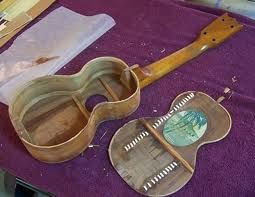Tigershark
Well-known member
- Joined
- Nov 5, 2012
- Messages
- 186
- Reaction score
- 2
Anybody on here have experience resetting the neck angle on vintage ukuleles? I'm looking for some info and hopefully some pictures of the inside of a Kumalae neck joint.

Popping off the back should be easy if it's not bound.
Most people call it a slipped block neck reset. Or a California neck reset. It was a primitive method for changing the neck angle in the bad old days. You really have to mutilate the instrument to do it. Here is some info:
http://www.acousticguitarforum.com/forums/showthread.php?t=138703
I wouldn't want to have this done to one of my ukes.
There may be some alternatives. The neck could be sawed off the body, the neck angle corrected, and then glued or doweled back on. Or take the whole neck & block assembly out, fill the gaps where it attached to the body with koa veneer, and recut those gaps at the proper angle and reattach. That would be slick, you might have to shave the top and shim the bottom of the part of the neck inside the body.
Slipping the back is done by only half separating the back to side seam...neck block to waist. I think in this case it would be easier to just take off the whole back, and that gives the luthier a chance to actually make the geometry better for modern playing and also get that back seam in better shape than it was new.
